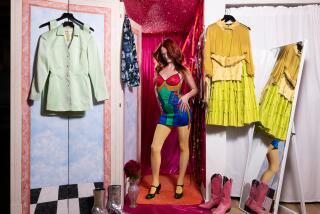Avon’s Fresh Face
- Share via
NEW YORK — After more than a century helping women spruce up their appearances with everything from pink lip liners to silky lingerie, Avon Products Inc.--one of the world’s foremost beauty matrons--is in the midst of its own make-over.
This is a crucial year for the New York beauty giant as it steps up efforts to overhaul its image as the affordable brand favored by middle-class housewives and seniors.
By investing millions in advertising, marketing and new products, Avon hopes to remake itself as a modern, glamorous and scientifically advanced brand that everyone from upwardly mobile baby boomers to hip twentysomethings will call their own.
But for the world’s largest direct-selling company with a 112-year history and $4.8 billion in global sales, reinventing itself is no simple feat. “It’s like turning around an ocean liner,” said Annette Green, president of the Fragrance Foundation, a nonprofit arm of the industry.
Because the Avon name evokes images of an “Avon lady” going door-to-door peddling yesterday’s lipstick shade, its advertising and marketing must be extensive, aggressive and effective on different fronts. Not only does Avon have to convince younger and more upscale women of its newfound chicness, it needs to better inform them of how to obtain its newly packaged and newly formulated products.
“Avon is going in the right direction, but it’s still not quite in the consumer’s eye the way it could be,” said Gabriella Zuckerman, president of a New York beauty marketing firm.
To change such conceptions, Avon plans to double its advertising budget by 2000, gearing its commercials toward modern, professional women, just as last year’s “Dare to Change Your Mind About Avon” campaign did. The company already had doubled its advertising to about $30 million in 1996. It spent $35 million last year.
At the same time, Avon is ditching slow-selling products. As part of its restructuring, Avon will cut 30% of its fragrance, cosmetics and toiletries lines.
Hoping to build its reputation as a beauty authority, Avon in April will launch a new beauty and fashion magazine with Hachette Filipacchi Magazines called “Athena: Common Sense, Uncommon Style.”
Its push for younger customers will come by way of ColorTrend, inexpensive cosmetics making a debut later this year. “It will be hip and fashion-forward with terrific packaging,” said Andrea Jung, Avon’s recently appointed president.
The company also hopes modest ventures into retailing will lure new customers in the United States, where only 35% of Avon’s business is generated. (About 16% of the company’s business is in Asia, 33% is in Latin America and Canada, and 16% is in Europe.)
*
Avon sales representatives now operate about 200 franchised beauty boutiques in Asia. But the company is moving more slowly in the United States, where it plans to open “express centers” in Washington, D.C., and possibly two other locations this year, adding to the Tampa, Fla., and San Francisco retail sites already opened. In addition, Avon’s first-ever spa and “image center” will debut in Manhattan, selling products, but mostly serving as a showcase for the company.
“It will be our version of Nike Town,” Jung said. “We want to create a vision of Avon.”
With 2.3 million sales representatives in 131 countries, Avon has to be careful not to disrupt its direct-selling foundation by delving too deeply into retailing.
“They have this incredible machinery of women, and they don’t want to denigrate what they’re doing for the company,” Green said. “But they need to add other components to their sales picture.”
Keenly aware of complaints that customers don’t know how to obtain its products, Avon has in recent years taken steps to improve its access. Unlike past days, when customers would have to wait for a representative to visit them at home, orders now can be called into a toll-free number, faxed or placed through the company’s Web site. Avon’s sales troops also have moved into the workplace, catering to women with little time to shop at stores.
“I think there’s more access than people believe,” said Diana K. Temple, a New York cosmetics industry analyst. “They have more than 2 million sales representatives worldwide. That’s an incredible distribution system.”
J.P. Morgan analyst Michael Grant agreed that the company doesn’t have to dramatically alter its selling structure. Avon’s direct-selling system is growing, he said, and has worked well in developing countries that don’t have strongly established retail structures.
In established markets such as the United States, effective advertising and marketing is the key to leading more customers to the company, analysts said.
“Avon needs to be developed into a brand that women feel is worth looking for,” said Suzanne Grayson, author of a Santa Barbara-based cosmetics marketing newsletter. “That’s what will make it accessible.”
Avon’s make-over began after a disappointing run in the 1980s, when it was slow to realize that many women had begun working outside the home. After three unsuccessful takeover attempts, it was saddled with debt, sagging sales and an outdated product line.
*
Under the leadership of Chief Executive James E. Preston, expected to be replaced this year by Charles R. Perrin, Avon began to turn itself around. (Perrin, the former chief of Duracell International Inc., was named Avon’s chief operating officer last month, disappointing some who expected a woman to be named.)
In 1992, the company introduced Anew, the first alpha-hydroxy acid product to be mass-marketed. By claiming that Anew could help reduce the signs of aging, Avon had a much-needed hit.
In January 1994, Jung arrived as president of marketing with the specific goal of revamping Avon’s image. Stylish and high-powered, the Princeton graduate and former Neiman Marcus Group executive is largely credited with orchestrating Avon’s turnaround.
“When I came to Avon, it was perceived as an outdated, old-fashioned beauty company,” said Jung, who some believe is being groomed to become the company’s first woman chief executive. “We had great products, but women were saying, ‘This is my grandmother’s makeup brand.’ ”
Jung called for Avon’s packaging to be redesigned. Younger and more stylish models were hired for ads. A new clothing line was introduced in 1994, and Avon Barbie dolls have been sold since 1996. The Anew skin-care line also was expanded to include other advanced products. And the swivel mechanism on lipsticks were changed.
Avon also continued expanding into such areas as China, Russia and Eastern Europe, where women embraced its products and signed up to be part of its sales force. Consumers in developing countries have no preconceived notion of the brand. To them, Avon represents Western glamour at a reasonable price.
Although U.S. sales have improved in recent years, Avon’s growth has been driven by its overseas markets. Avon now ranks seventh in worldwide beauty sales, behind L’Oreal, Procter & Gamble Co., Unilever, Shiseido Co., Estee Lauder Cos. and Johnson & Johnson, according to last September’s Women’s Wear Daily’s ranking.
*
During the first nine months of 1997, the company reported a net income of $205 million, compared with $186 million in the same period the year before.
Last November, however, the company warned that it would not make its fourth-quarter earnings estimates, blaming its problems on the rapid deterioration of the Brazilian economy. Currency fluctuations in Asia and tighter regulatory controls on direct marketing in China also hurt the company during the last quarter of 1997.
After the announcement, Avon stock dropped 11%. It has since recovered, but is still down from last July’s high.
Still, Jung remains optimistic about Asia in 1998, because she believes the currency devaluations may help Avon recruit more sales representatives in the region.
Other Wall Street analysts also are still recommending Avon stock, pleased with its image overhaul and plan to offer fewer discounts, make fewer products and use fewer suppliers to save as much as $400 million a year by 2000.
Avon plans to reinvest half of its annual savings in advertising and marketing to target women in mainly established markets such as the United States.
“We want our advertising to stand out in the crowd,” Jung said.
(BEGIN TEXT OF INFOBOX / INFOGRAPHIC)
Improved Complexion
Since Avon began a push to revamp its business, its sales and stock price have steadily increased. The company credits beefed-up advertising and marketing, innovative products and success in emerging markets. Sales and earnings for the fourth quarter of 1997 will be lower than expected, primarily because of economic troubles in Latin America and Asia.
Worldwide net sales (in billions)
1996: $4.81
Year-end stock prices
1997: $61.36
Source: Avon Products Inc.






